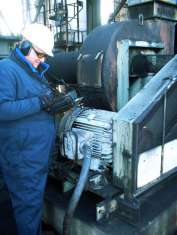Predictive Maintenance 
Why Predictive Maintenance?
Predictive maintenance is condition-based maintenance and not reaction-based or time-based maintenance. By taking this proactive approach to maintenance, a company can inspect their equipment without interruption to diagnose their machinery health in much the same way a physician helps his patients. Predictive maintenance is taking preventive maintenance one step further in an effort to control costs and maximize profits. There are many types of programs. The following are explanations of the most cost efficient and commonly used predictive maintenance techniques.
Infrared Electrical Inspections:
The maintenance cost of electrical inspections can be significantly reduced by a good predictive maintenance program. An infrared inspection should be the cornerstone of a company’s program. Infrared inspections can detect loose connections, overloads, improper transformer connections etc. that can cost a company thousands of dollars a year in wasted energy. Infrared inspections can also save company money in unscheduled shutdowns, overtime for repairs due to electrical problems and overhead cost of materials sitting on stock shelves.
Infrared Roof Inspections
Contrary to popular belief, infrared inspections are not used solely on electrical components. It can also find water leaks on flat roofs. Without infrared, moisture in the roof is invisible to the naked eye. By using infrared, moisture trapped in the insulation can be detected. Once the damage area is detected, a roofing contractor can be called out to give an estimate on repairing just the damaged area instead of the entire roof.
Vibration Analysis:
Vibration analysis is used to monitor critical rotating machinery to determine the effects that vibration is having on that machinery. A good vibration analysis survey can determine if the machinery is out of alignment or unbalanced, if belts are worn or loose, if gear teeth are worn or chipped, and the extent of damage that these common problems have caused. Vibration analysis can even determine how bad the bearing damage is – preventing unscheduled downtime. Many times companies rely on their spare parts to see them through these unnecessary downtimes without knowing the condition of their spares. By using monthly vibration analysis, a company can trend the bearing deficiency and determine when they can fix the problem. This can save thousands of dollars a year in overtime, wasted energy and excess parts.
Ultrasound Inspections:
Ultrasound is used to detect escaping air, steam and natural gas from fittings, joints and holes in pipes and conduit. The amount of escaping gases can greatly effect the productivity of a company that requires these gases to operate their machinery or produce their goods. It is not uncommon for a company to gain 15-20 psi and save $10,000 per year in wasted energy using ultrasound in their program.

